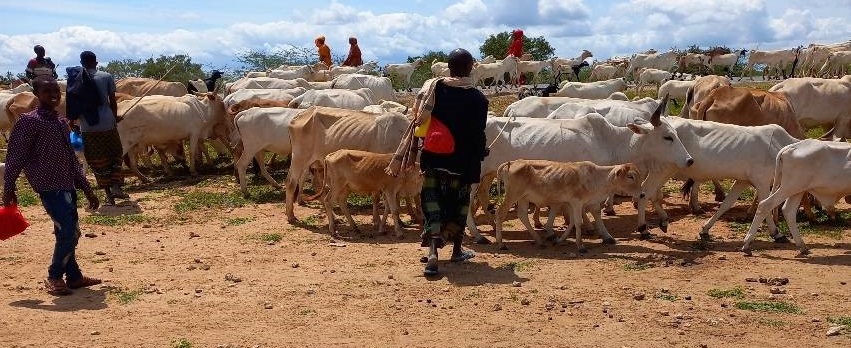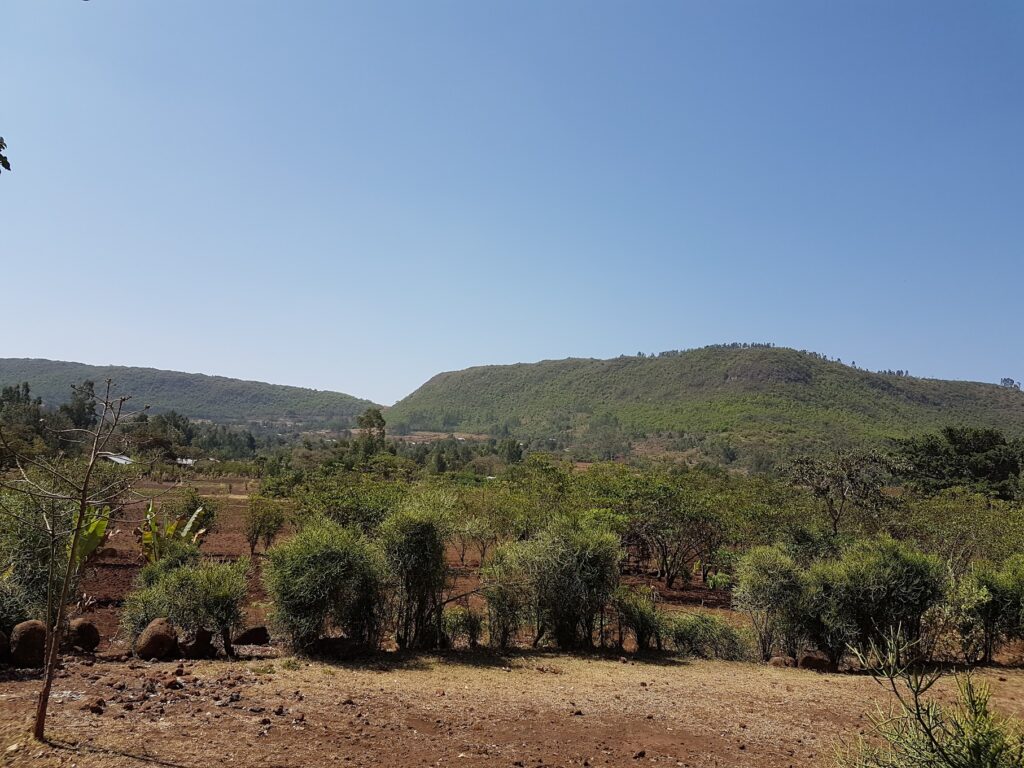Climate
Juba, South Sudan | Peter Caton
The Horn of Africa experiences extreme variations in climate, and uncertainty over climatic conditions. This manifests in erratic rainfall, high temperatures, prolonged droughts, increasing floods and intensifying land degradation.
Political conflict, economic insecurity and weak governance have further compounded the negative effects of environmental change.
What are our key findings on climate and mobility in the Horn of Africa?
Many pastoralists have to move longer distances in order to sustain their livelihoods.
Mobility has always been an important way for pastoralists to innovatively exploit environmental changes but the degree to which this mobility is voluntary has changed. As a result, there has been a marked increase in the number of cross-border migrants and internally displaced people (IDPs).
When environmental factors overlap with socioeconomic realities, they may lead to some people moving in new ways, while others may be unable to move.
The relationship can also be seen in reverse – with migration affecting the environment.
This is visible in the rapid urbanisation of the Horn of Africa, and where the large-scale movement of people has led to the establishment of camps and settlements, for example, in internal displacement, rural-to-urban migration and forced displacement. These movements, in turn, put pressure on available resources in hosting areas.
For policy makers and practitioners, we recommend:

An approach that views mobility as adaptation to a problem, instead of a problem in itself.

Climate policy informed by social sciences as well as physical sciences.

Policies that consider the lifestyle of pastoral and agro-pastoral communities.
Our research on mobility and climate in the Horn of Africa
What’s the link between climate and migration debates in the region?
Climate policy debates are often more extensively informed by the physical sciences than the social sciences. At the global level, we tend to focus on reducing carbon emissions as a means of slowing global warming. At the local level, we often emphasise efforts to reduce the physical impacts of climate change – such as reforestation, agricultural support and flood protection.
We give much less attention to the adaptive behaviours that populations affected by climate change engage in, including mobility.
In development policy broadly speaking, migration is often seen as being a problem to be solved rather than a potentially positive form of adaptation. As a result, migration continues to be framed in terms of displacement and disasters. This negative framing can prevent us from considering migration to be a potential adaptation strategy when formulating climate policy and programmes. It hides the already existing mobilities that are a key part of life for many communities in the Horn of Africa, and which help people to have viable livelihoods in challenging environments. This is a gap that needs addressing.
In depth: Environmental stress and mobility
In 2022-2023, the Research and Evidence Facility set out to understand how people living with environmental stress make decisions about mobility in the Horn of Africa.
Researchers focused on three study sites, located in the Hawd zone of the Togdheer and Maroodijeex regions of Somaliland, the Fafan and Doollo Zones of the Somali Regional State of Ethiopia, and the Tana River Basin of coastal Kenya. Alongside this, they considered how mobility and displacement have adapted to changing climatic conditions and how this movement is – or is not – framed in climate policy, programmes and research.
Pastoral production systems in the Somali Region of Ethiopia and in Togdheer and Maroodijeex in Somaliland have relied on mobility – including moving livestock from one grazing ground to another in a seasonal cycle, and trekking livestock to different markets. These areas are part of the wider ‘Somali export zone’, where commercial livestock keeping is a major – if not the most important – contributor to the economy.
Communities in the region have moved from a livestock-based subsistence economy to one based on the export of livestock. Here, informal and formal cross-border livestock trade is sustained through complex social networks that link the rangelands with the ports of Berbera and Bosaso through a series of clan-based corridors. Livestock from Ethiopia, Somalia and Somaliland are sold in terminal markets in Togwajale, Hargeisa and Burao, and the contributions from these large-scale livestock sales are estimated at over US$400 million annually (Eid: 2014).
Commercialisation of livestock has occurred while grazing areas have shrunk, rangeland has been converted into agricultural land, and large areas of land have been privatised for individual households. This has had critical implications for livestock mobility and human settlements, which have in turn also contributed to environmental change. Take, for example, the impact of the proliferation of berkads or water cisterns in the Hawd zone in Somaliland. Whereas the rangeland was traditionally used in the rainy seasons to feed herds, the area is increasingly grazed all year round, because stored water is available from berkads. This means the rangeland can’t regenerate.
In Ethiopia’s Somali Region, land fragmentation has not only resulted in drastically reduced livestock mobility, it has also driven a breakdown of collective and cooperative pastoral systems. Changes in land use have also led to more pastoralists adopting a settled way of life. For instance, in many parts of the Hawd zone of Somaliland, villages are now reportedly 20 kilometres apart, thanks to the mushrooming of settlements around water points.
How do pastoralists experience climate change?
The 2017 Somaliland National Development Plan recognises that economic production and trade are dominated by the livestock sector, which provides a livelihood to as much as 34% of the population. With livestock accounting for around 30% of gross domestic product, the impact of drought is a significant economic threat.
But the impact of drought is no longer unusual to pastoral and agro-pastoral communities living in the Hawd zone of Somaliland. As researcher Mohamed Fadal puts it, they know more about climate change than those responsible for formulating development policy and programming, but “nobody asks them or bothers to tap into their rich traditional knowledge”.
This study drew mostly on qualitative methods – key informant interviews and focus group discussions, with a total of 108 participants.
The research team also used participatory mapping to understand migration patterns and how they’ve changed. This gave insights into changes in grazing areas over time, the movements of people out of rural areas, and how interventions such as the drilling of boreholes or construction of berkads have led to temporary or permanent settlements. The mapping exercise also prompted discussions around changes to land use, movement, livelihoods, conflict trends and the availability of services.

Participatory map produced with focus group participants in Bali Mataan, Somaliland, by Mohamed Fadal.
Read more about closing the environment—migration gap in climate policy and programmes.
For pastoral and agro-pastoral communities in Somaliland, cimilo (the climate) is extremely important for their livelihoods.
In Goljano, Ethiopia, a participant described changes to grazing areas:
“the grasses were as tall as us when we were young. We used to hide and play in the tall grasses just in front of our houses. Now, look at every corner, it [is] just dust, no grass.”
Traditional methods for planning livelihood activities depended on interpreting wind directions and seasonal temperature changes, for example, to predict the timing and strength of seasonal rains. All these indicators are changing as a result of climate change. This makes it difficult to plan livestock breeding periods, seasonal migrations, decisions about storing water for the dry season, and sales of farm and livestock products.
Elders consulted for the study in the Yo’ob area of Ethiopia said:
“we used to read stars and forecast the upcoming year’s weather. None of these predictions no longer hold the water… But those forecasting things are sin and now we have discarded it as we shall not interfere with Allah’s will.”
Organisations like the UN Office for the Coordination of Humanitarian Affairs (OCHA), the World Food Programme (WFP), the Food and Agriculture Organization (FAO) and others have access to early warning systems to predict shifts in the climate. But district officials in Ethiopia’s Somali Regional State pointed out that no climate-related early warning information was regularly communicated to them that would enable them, in turn, to inform the community and take the necessary preventive measures. In Somaliland, the National Disaster Preparedness and Food Reserve Authority, established in 2018, is responsible for producing a Drought Early Warning Monthly Report, alongside other activities that have made it the lead official agency for drought preparedness.
Environmental change has changed the nature of livelihoods, as well as how people plan them. In Somaliland, communities have become dependent on sheep and goats rather than camel herds, which have become labour-intensive and costly to maintain. Camels also require longer migrations to access pasture and water, which runs against the increasing sedentarisation of communities, and their experimentation with rain-fed agriculture. Research participants mentioned that people in the area had sold off even their pack camels, which they had previously used for transport.
Although conflict remains the main driver of displacement in Ethiopia, environmental change has also shaped various forms of mobilities. Agricultural productivity has fallen and food insecurity has risen, according to the World Food Programme, leading to a rise in rural unemployment. Many people, especially the young, are moving between rural areas and to urban centres. Young people move to other rural locations with the seasons, to work in agricultural jobs, such as in sugar plantations or in construction.
Meanwhile, a massive influx of youth migrants to urban centres in Ethiopia has outpaced the opportunities for work or education. This means many young migrants have been forced into street vending, a precarious livelihood with little to no protection. In rural destinations, a lack of employment opportunities, social protection or government safety nets may mean migrants become trapped in locations where temporary labour is no longer available. Not only does this decrease young people’s resilience, in a situation of economic precarity they may also become potential recruits for non-state armed actors, such as ethnic militias.
Explore more themes



